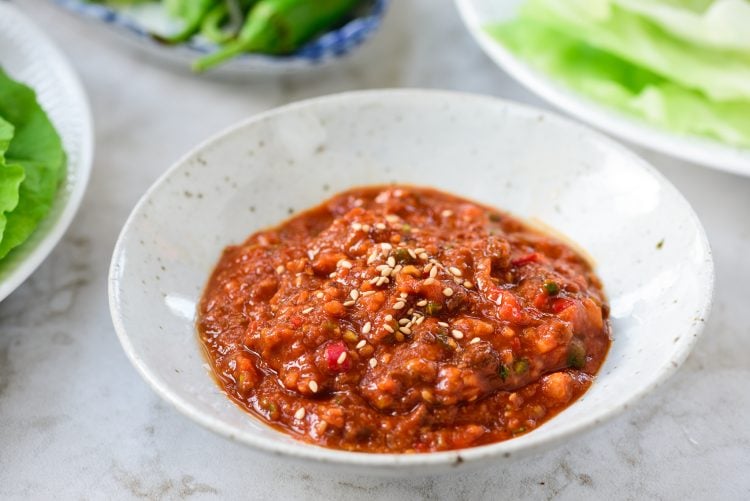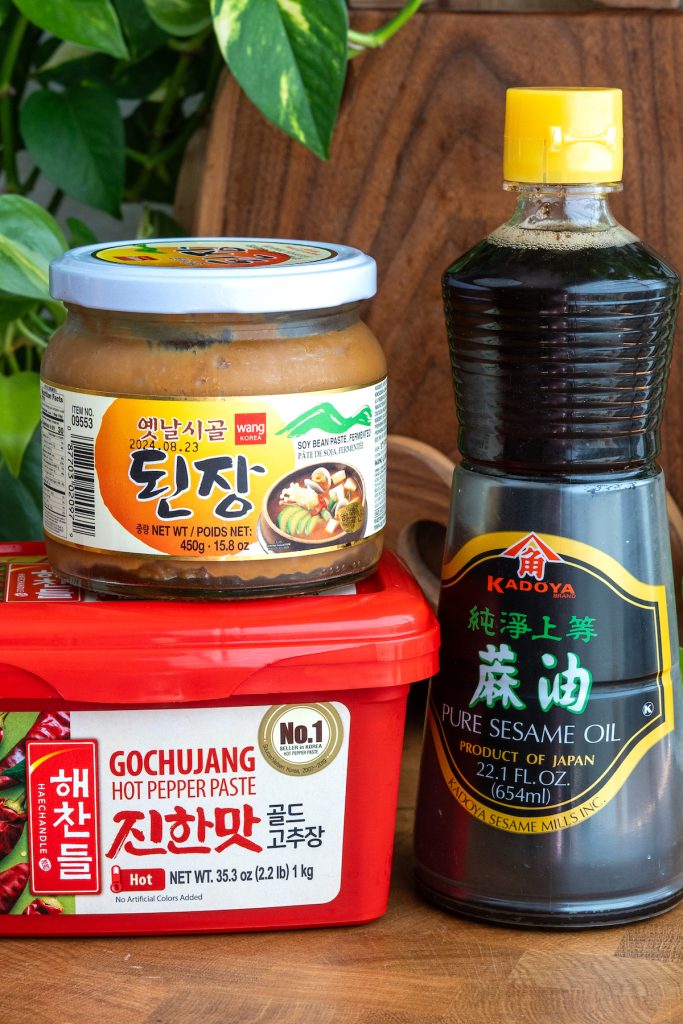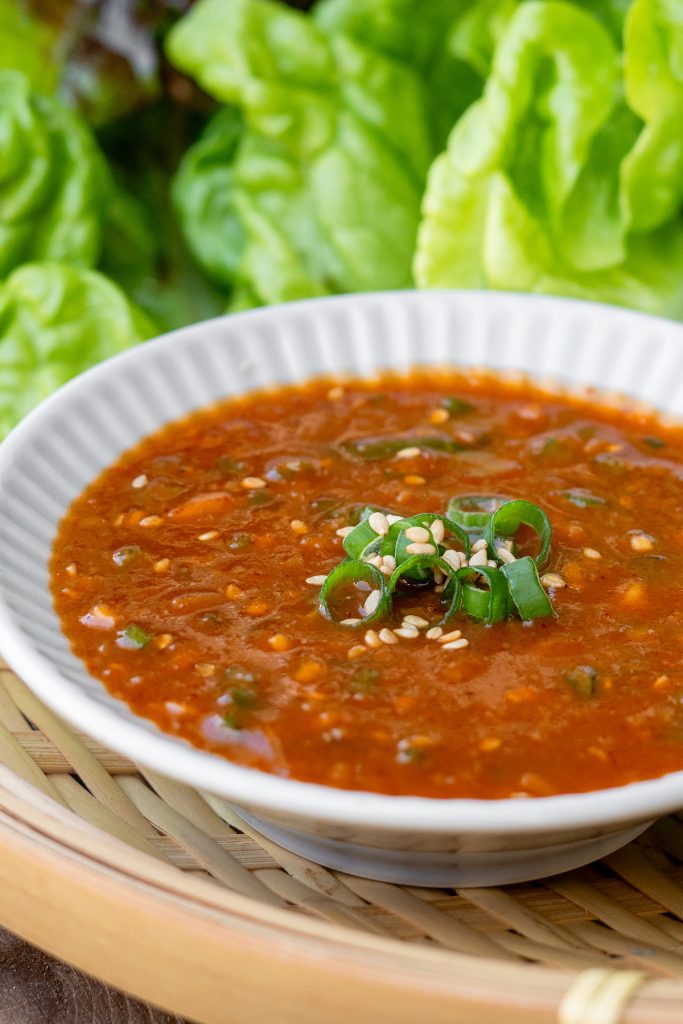If you are not including ssamjang in your Korean barbecue spread, you are doing it incorrectly! This is only a joke; there is no incorrect way to prepare Korean barbecue. However, ssamjang is the most superior of all Korean dipping sauces, and it is one of the best ways to take any Korean barbecue experience to the next level.
Introduction
There are many different foods that may be prepared with ssamjang, which is a Korean dipping sauce that is both flavorful and versatile. According to a significant portion of Korean cuisine, the sauce is the primary component that serves as the primary component.
This is because the sauce is the primary component. Ssamjang is available in a broad variety of flavours, each of which is distinct from the others. A condiment that can be used to enhance a wide variety of foods, from grilled meats to fresh vegetables, ssamjang is distinguished by its robust umami taste and fiery punch. It is a flexible condiment that can be used to enhance a wide variety of foods.
It has the potential to improve the flavour of a wide variety of cuisines. A sense of depth and complexity is imparted upon the meal as a result of this, which contributes to the overall appeal of the occasion.
The paragraphs that are to follow are going to be devoted to a discussion of the history of ssamjang as well as the cultural relevance of this art form. More than that, we will investigate its essential constituents and flavour profile, and we will provide you with a variety of recipes and suggestions for presentation that will assist you in adopting this delectable sauce into your own personal culinary arsenal. With any luck, you will find this material to be of some use to you.

History
Ssamjang is a Korean dipping sauce that has a long and illustrious history that is deeply based in the culinary traditions of Korea. The term “ssamjang” refers to this sauce. This sauce is an indispensable component of the Asian cuisine known as Korean.
Ssamjang, which literally translates to “wrapped sauce,” is a condiment that has been enjoyed for millennia and is recognised for its flexibility. “Wrapped sauce” is the literal translation of the word. It is well-known for its flexibility as well as its savoury features, and one of its most notable qualities is its versatility.
The following material is included in this condensed version of the history of ssamjang, which is as follows:
- Origins: Ssamjang is believed to have originated during the Joseon Dynasty (1392-1910) in Korea. It was traditionally made by mixing doenjang (fermented soybean paste) and gochujang (fermented chili paste) with other seasonings such as garlic, sesame oil, and green onions.
- Culinary Significance: Ssamjang is an integral part of Korean cuisine and is commonly used as a dipping sauce for grilled meats, vegetables, and Korean barbecue. It is also used as a condiment for various dishes, including bibimbap (mixed rice bowl) and ssam (lettuce wraps).
- Cultural Symbolism: Ssamjang is not just a sauce but also a symbol of Korean culinary heritage. It is often served during traditional Korean holidays and celebrations, as well as everyday meals.
- Evolution: Over the years, ssamjang has evolved to include different variations and flavors. Some modern versions of ssamjang include additional ingredients such as sesame seeds, honey, or vinegar to enhance its flavor profile.
- Health Benefits: Ssamjang is not only delicious but also nutritious. It is made from fermented soybeans, which are rich in protein, fiber, and antioxidants. The fermentation process used to make doenjang and gochujang also creates beneficial probiotics, which are important for gut health.
- Popularity: Ssamjang has gained popularity outside of Korea, with many people around the world enjoying its unique flavor and versatility. It is now readily available in many Asian grocery stores and is used in a variety of fusion dishes.
:max_bytes(150000):strip_icc()/__opt__aboutcom__coeus__resources__content_migration__serious_eats__seriouseats.com__2019__07__20190619-korean-bbq-vicky-wasik-28-961e7fe053d14d6c8e680f475a468c66.jpg)
Ingredients
- Doenjang (fermented soybean paste): Doenjang forms the base of ssamjang and provides a rich, savory flavor. It is similar to miso but has a stronger, more pungent taste.
- Gochujang (fermented chili paste): Gochujang adds heat and depth of flavor to ssamjang. It is made from fermented soybeans, chili peppers, and rice, giving it a sweet, spicy, and slightly tangy taste.
- Garlic: Garlic is a key ingredient in ssamjang, adding a pungent and aromatic flavor to the sauce.
- Sesame oil: Sesame oil adds a nutty flavor and richness to ssamjang. It is used in moderation as a little goes a long way.
- Sugar: A small amount of sugar is often added to ssamjang to balance the flavors and add a touch of sweetness.
- Soy sauce: Soy sauce adds saltiness and umami to ssamjang, enhancing its overall flavor profile.
- Green onions: Green onions are commonly added to ssamjang for a fresh, oniony flavor and added texture.
- Toasted sesame seeds: Toasted sesame seeds are sometimes added to ssamjang for a nutty flavor and crunchy texture.
- Optional ingredients: Some recipes may include additional ingredients such as rice vinegar, honey, or Korean pear for added sweetness and complexity.
These ingredients are mixed together to create a thick, flavorful sauce that is perfect for dipping grilled meats, vegetables, and other Korean dishes. Adjust the quantities of each ingredient to suit your taste preferences.

Optional Ingredients
-
The Origins of Ssamjang:
- Ssamjang has its roots in traditional Korean cuisine, where it was originally developed as a dipping sauce for grilled meats and vegetables.
- The name “ssamjang” is derived from the Korean words “ssam” (wrapping) and “jang” (sauce), reflecting its use as a condiment for wrapping meats and other ingredients in lettuce or perilla leaves.
-
Key Ingredients and Flavor Profile:
- Ssamjang is made from a base of fermented soybean paste (doenjang) and chili paste (gochujang), which give it its distinctive flavor and color.
- Other common ingredients in ssamjang include garlic, sesame oil, and green onions, which add depth and complexity to the sauce.
- The combination of savory, spicy, and slightly sweet flavors in ssamjang makes it a versatile and delicious condiment.
-
Health Benefits of Ssamjang:
- Ssamjang is not only delicious but also nutritious, as it is made from fermented soybeans, which are rich in protein, fiber, and antioxidants.
- The fermentation process used to make doenjang and gochujang also creates beneficial probiotics, which are important for gut health.
-
How to Make Ssamjang:
- I’ll provide a detailed recipe for making ssamjang at home, including step-by-step instructions and tips for adjusting the flavor to suit your taste.
- I’ll also discuss the different variations of ssamjang, such as adding sesame seeds or honey for a different flavor profile.
-
Serving Suggestions and Recipes:
- I’ll offer a variety of serving suggestions for ssamjang, including using it as a dipping sauce for grilled meats, a condiment for bibimbap, or a marinade for tofu or vegetables.
FAQs
Q: What is ssamjang? A: Ssamjang is a Korean dipping sauce and condiment made from a mixture of fermented soybean paste (doenjang), fermented chili paste (gochujang), garlic, sesame oil, and other seasonings. It is known for its savory, spicy, and slightly sweet flavor profile.
Q: How is ssamjang used in Korean cuisine? A: Ssamjang is a versatile condiment used in Korean cuisine. It is commonly used as a dipping sauce for grilled meats, vegetables, and Korean barbecue. It is also used as a condiment for dishes like bibimbap (mixed rice bowl) and ssam (lettuce wraps).
Q: What does ssamjang taste like? A: Ssamjang has a complex flavor profile that is savory, spicy, and slightly sweet. The fermented soybean paste and chili paste give it a rich umami flavor, while the garlic and sesame oil add depth and richness.
Q: Can ssamjang be made at home? A: Yes, ssamjang can be made at home using simple ingredients like fermented soybean paste, fermented chili paste, garlic, sesame oil, and sugar. Homemade ssamjang can be customized to suit your taste preferences.
Q: Is ssamjang spicy? A: Ssamjang can be spicy, depending on the amount of fermented chili paste (gochujang) used in the recipe. Some recipes call for more gochujang for a spicier sauce, while others use less for a milder flavor.
Q: How long does ssamjang keep? A: Ssamjang can be stored in an airtight container in the refrigerator for several weeks to a few months, depending on the ingredients used. It is best to check for any signs of spoilage, such as mold or off odors, before consuming.
Conclusion:
It is widely acknowledged that ssamjang, a sauce that is not only savoury but also versatile, is among the most important aspects and components that are utilised in Korean cuisine.
The fact that it is healthy to one’s health adds to the charm of this dish, which is already enticing due to the fact that it has a savoury umami flavour and a hot bite.
A wide range of recipes can benefit greatly from the addition of this ingredient. It is guaranteed that ssamjang will become an indispensable component in your kitchen, regardless of whether you are a lover of Korean cuisine or simply want to add some flavour to the dishes you prepare.
Regardless of whether or not you are a fan of Korean cuisine, this is something that you should know.


